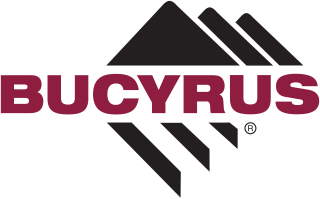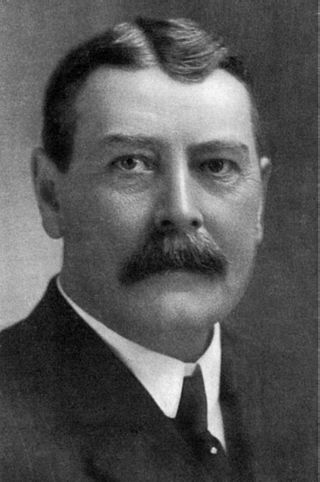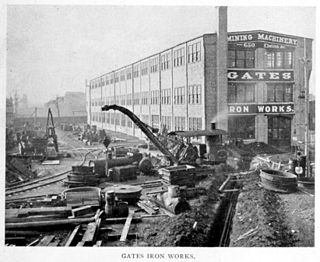
Henry Harnischfeger (July 10, 1855 – November 15, 1930) was a pioneer in the Milwaukee, Wisconsin, mining industry. [1]

Henry Harnischfeger (July 10, 1855 – November 15, 1930) was a pioneer in the Milwaukee, Wisconsin, mining industry. [1]
Harnischfeger was born in Salmünster, Kreis Schlüchtern, Hessen-Nassau, on July 10, 1855. He left his homeland in 1872 and came to the United States. He arrived in the U.S. on April 9, and was employed by Singer Sewing Machine Company, which is now known as the Singer Corporation. He worked there for 9 years, and then came to Milwaukee, Wisconsin. He then worked for the White Hill Sewing Machine Company where he managed castings patternmaking and gear machining operations within the Whitehill factory with Alonzo Pawling. They formed a machine and pattern shop on December 1, 1884. [2] to manufacture, assemble and service components and equipment needed by other, larger manufacturing firms in the region.
In 1883 Pawling opened up Milwaukee Tool and Pattern Shop with Mauritz Weiss. The partnership dissolved after one year, and Harnischfeger took over Weiss' interests. Their customers included industrial knitting machine manufacturers, brick makers, grain drying equipment manufacturers and beer brewers.
They Manufactured valves for Bruno V. Nordberg. Bruno left Allis and rented the loft space above Pawling and Harnischfeger.
Christopher W. LeValley also came to the shop for custom work. He went on to found the Chain Belt Company
Frederick Pabst, who at that the time owned Best Brewing Company with Emil Schandein, gave them brewery equipment orders. [3] In 1887, Pawling and Harnischfeger helped rebuild and upgrade an overhead bridge crane within the foundry operations of the Edward P. Allis Manufacturing Company, owned by Edward P. Allis, that collapsed following an attempt to move a load beyond its rated lifting capacity. The rebuilt crane featured a simplified system of motors and gearboxes to drive the bridge, trolley and hoist functions on the lifting machine, replacing a complex system of ropes and pulleys that failed on the earlier version. Soon after, Pawling and Harnischfeger began building their own line of overhead cranes for manufacturing and warehouse operations.
The Panic of 1893 caused demand to fall for the cranes designed and built by Pawling and Harnischfeger who by that time were being referred to as “P&H”. The partners expanded their product line to include earthmoving machines in order to increase the ability of their business to withstand the next economic downturn. In 1893 P&H acquired the motors and controls manufacturing assets of the Gibb Electric Company following the acquisition of Gibb by Westinghouse Electric Manufacturing Company, as Pawling and Harnischfeger wanted control over the application of motors applied to their crane line.
The Pawling & Harnischfeger business had become known as Harnischfeger Corporation following the death of Alonzo Pawling in 1911. [4] By the mid-1920s, the firm had become a large and growing supplier of crawler-mounted shovels and cranes applied to construction and mining operations – all bearing the familiar “P&H” trademark that had become synonymous with exceptional quality and service value established by Pawling & Harnischfeger. Over the ensuing decades, P&H-trademark shovels and cranes would grow in size, capacity and drives and controls technology. The firm expanded its product line with the onset of the Great Depression, adding welding machinery, diesel engines and prefabricated homes to its P&H line of shovels and cranes.
Henry died unexpectedly from heart failure November 15, 1930, at 75 years old. The active management of Harnischfeger Company then went to his son, Walter Harnischfeger, a pro-nazi patron of Joseph McCarthy. [5]
The Harnischfeger Mansion, which was built in 1905, is still standing at North 35th St. and West Wisconsin Avenue in Milwaukee. [6] [7]

Heavy equipment, heavy machinery, earthmovers, construction vehicles, or construction equipment, refers to heavy-duty vehicles specially designed to execute construction tasks, most frequently involving earthwork operations or other large construction tasks. Heavy equipment usually comprises five equipment systems: the implement, traction, structure, power train, and control/information.

A dragline excavator is a heavy-duty excavator used in civil engineering and surface mining. It was invented in 1904, and presented an immediate challenge to the steam shovel and its diesel and electric powered descendant, the power shovel. Much more efficient than even the largest of the latter, it enjoyed a heyday in extreme size for most of the 20th century, first becoming challenged by more efficient rotary excavators in the 1950s, then superseded by them on the upper end from the 1970s on.

Komatsu Ltd. or Komatsu (コマツ) is a Japanese multinational corporation that manufactures construction, mining, forestry and military equipment, as well as diesel engines and industrial equipment like press machines, lasers and thermoelectric generators. Its headquarters are in Minato, Tokyo, Japan. The corporation was named after the city of Komatsu, Ishikawa Prefecture, where the company was founded in 1921. Worldwide, the Komatsu Group consists of Komatsu Ltd. and 258 other companies.

Allis-Chalmers was a U.S. manufacturer of machinery for various industries. Its business lines included agricultural equipment, construction equipment, power generation and power transmission equipment, and machinery for use in industrial settings such as factories, flour mills, sawmills, textile mills, steel mills, refineries, mines, and ore mills.

A line shaft is a power-driven rotating shaft for power transmission that was used extensively from the Industrial Revolution until the early 20th century. Prior to the widespread use of electric motors small enough to be connected directly to each piece of machinery, line shafting was used to distribute power from a large central power source to machinery throughout a workshop or an industrial complex. The central power source could be a water wheel, turbine, windmill, animal power or a steam engine. Power was distributed from the shaft to the machinery by a system of belts, pulleys and gears known as millwork.

Marion Power Shovel Company was an American firm that designed, manufactured and sold steam shovels, power shovels, blast hole drills, excavators, and dragline excavators for use in the construction and mining industries. The company was a major supplier of steam shovels for the construction of the Panama Canal. The company also built the two crawler-transporters used by NASA for transporting the Saturn V rocket and later the Space Shuttle to their launch pads. The company's shovels played a major role in excavation for Hoover Dam, the Holland Tunnel and the extension of the Number 7 subway line to Main Street in Flushing, Queens.

Demag was a German heavy equipment industrial group whose individual companies are now scattered. The Demag name can be today found for example as the Demag Cranes and Components and Sumitomo (SHI) Demag.

Bucyrus-Erie was an American surface and underground mining equipment company. It was founded as Bucyrus Foundry and Manufacturing Company in Bucyrus, Ohio, in 1880. Bucyrus moved its headquarters to South Milwaukee, Wisconsin, in 1893. In 1927, Bucyrus merged with the Erie Steam Shovel Company to form Bucyrus-Erie. In 1997, it was renamed Bucyrus International, Inc. In 2010 the enterprise was purchased by Caterpillar in a US$7.6 billion transaction that closed on July 8, 2011. At the time of its acquisition, the Bucyrus product line included a range of material removal and material handling products used in both surface and underground mining.

A hoist is a device used for lifting or lowering a load by means of a drum or lift-wheel around which rope or chain wraps. It may be manually operated, electrically or pneumatically driven and may use chain, fiber or wire rope as its lifting medium. The most familiar form is an elevator, the car of which is raised and lowered by a hoist mechanism. Most hoists couple to their loads using a lifting hook. Today, there are a few governing bodies for the North American overhead hoist industry which include the Hoist Manufactures Institute, ASME, and the Occupational Safety and Health Administration. HMI is a product counsel of the Material Handling Industry of America consisting of hoist manufacturers promoting safe use of their products.
Magnetek, Inc., is a technology company founded in 1984 and headquartered in Menomonee Falls, Wisconsin, and is a NASDAQ Global Market listed company. The company develops, manufactures, and markets digital power and motion control systems for material handling, people-moving and mining applications. Its power control systems serve the needs of selected niches of traditional and emerging commercial markets that are becoming increasingly dependent on "smart" power. Magnetek operates four ISO9001:2008 certified research and manufacturing facilities in North America.

Ruston-Bucyrus Ltd was an engineering company established in 1930 and jointly owned by Ruston & Hornsby based in Lincoln, England, and Bucyrus-Erie based in South Milwaukee, Wisconsin, the latter of which had operational control and into which the excavator manufacturing operation of Ruston & Hornsby was transferred. The Bucyrus company proper, from which the Bucyrus component of the Ruston-Bucyrus name was created, was an American company founded in 1880, in Bucyrus, Ohio.

P&H Mining Equipment sells drilling and material handling machinery under the "P&H" trademark. The firm is an operating subsidiary of Joy Global Inc. In 2017 Joy Global Inc. was acquired by Komatsu Limited of Tokyo, Japan, and is now known as Komatsu Mining Corporation and operates as a subsidiary of Komatsu.

Joy Global Inc. was a company that manufactured and serviced heavy equipment used in the extraction and haulage of coal and minerals in both underground and surface mining. The company had manufacturing facilities in Alabama, Pennsylvania, Texas, Wisconsin, Australia, Canada, China, France, South Africa, Poland and the United Kingdom. In 2017, Joy Global was acquired by Komatsu Limited and was renamed Komatsu Mining Corp.

Edward H. Zinn was an American mechanical engineer, tax assessment clerk and Socialist from Milwaukee, Wisconsin who served two terms (1913–1916) as a member of the Wisconsin State Assembly representing the 7th Milwaukee County Assembly district (7th and 10th wards of the city of Milwaukee.

Edward Phelps Allis was an American businessman who founded the Edward P. Allis Company, a manufacturer of milling and mining equipment, steam engines, and other large-scale capital equipment. He was a notable ideologue in the Greenback Movement, running for governor of Wisconsin as a candidate of the Greenback Party. About a decade after his death, his company merged with others to form the Allis-Chalmers Manufacturing Company. In 1883, Allis was elected a fellow of the American Society of Civil Engineers.

The Louden Machinery Company was an American engineering, manufacturing and design company based in Fairfield, Iowa. Founded by William Louden, the company in its early years manufactured and sold the patented hay carrier that he invented in 1867. The company later expanded into a wide variety of farm equipment and, in 1906, began an Architecture Department that reportedly designed more than 25,000 barns from 1906 to 1939. During World War I, Louden's monorail equipment carrier began to be applied to industrial and military applications. By the 1920s, much of the company's revenues were derived from industrial applications of its monorail equipment carriers.
Chain Belt Company was an agricultural equipment manufacturer in the US. It produced chain belts specifically to replace leather-based belts, which were used inside engine-powered agricultural equipment at the time.

Gates Iron Works was a U.S. manufacturer of machinery, specialized in rock and cement milling equipment. It was based in Chicago and merged into the Allis-Chalmers Company in 1901
Kirchhoff & Rose was an architectural firm in Milwaukee, Wisconsin. The partnership began in 1894 between Charles Kirchhoff Jr. and Thomas Leslie Rose.

Edwin Reynolds was an American mechanical engineer, consulting engineer and inventor, and president of the American Society of Mechanical Engineers in the year 1902-03. He is known for the development of the Corliss-Reynolds triple expansion pumping engine for water works.